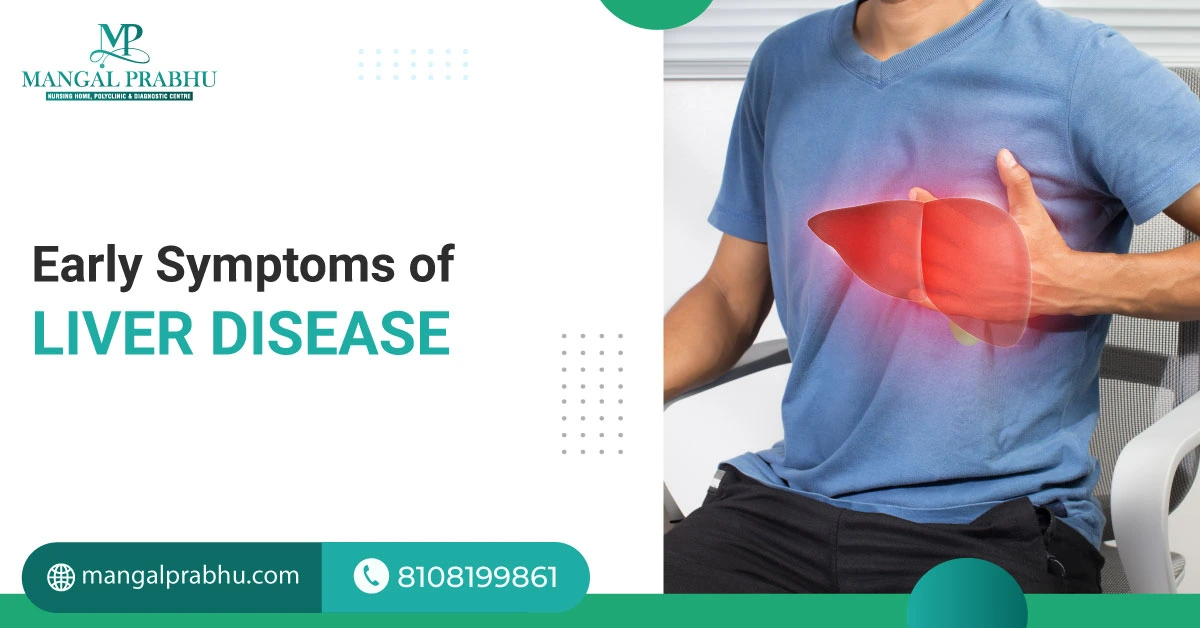
Early Symptoms of Liver Disease
Your liver is one of the largest internal organs and has many functions—from aiding digestion to filtering toxins from your blood. However, in the process of filtering out toxins, the liver is exposed to many harmful substances that can damage it instantly or gradually. In this post, we’ll look at the early symptoms of liver disease and when to see a gastroenterologist in Navi Mumbai.
Early Symptoms of Liver Disease
Exposing your body to too many toxic substances or contracting viral infections frequently can put your liver into overdrive. Your liver has the ability to regenerate itself, but it can’t work overtime or handle excessive pressure regularly. As a result, it can get damaged over time. This can lead to chronic liver disease. Here are some early symptoms people with chronic liver disease are likely to experience.
a) Fatigue and Weakness:
Fatigue associated with liver problems is not the typical tiredness. It’s rather a persistent symptom. You may feel tired despite resting, eating a balanced diet, and making lifestyle changes.
b) Hepatitis:
The most noticeable symptom of liver disease is hepatitis infection. It’s an acute viral infection that causes fever, nausea, and stomachache. Your immune system fights the infection, and it will clear shortly, but if it persists, it could be chronic hepatitis, suggesting liver damage.
c) Weight Loss:
You may not be interested in eating food due to nausea and digestive problems linked to chronic liver diseases, which can lead to weight loss. Other reasons include an ineffective metabolism. Your liver may not function well, which makes it hard for your body to absorb and process the essential nutrients normally, causing a drastic drop in your weight.
Less Obvious Early Symptoms of Liver Disease Symptoms
i) Itchy Skin:
People mistake itchy skin for dry skin and rash. While those can be possible causes, persistent itching accompanied by unexplained fatigue and weight loss can indicate liver issues.
ii) Swollen Abdomen:
Your abdomen can get filled with fluid if your liver disease has reached an advanced stage. This fluid accumulation can make you look bloated. It also makes the upper right side of your abdomen tender.
iii) Dark Urine and Pale Stool:
A sudden change in your urine and stool colors can be due to liver disease. Inadequate bile production or improper absorption of nutrients can lead to darker urine, even if you are drinking enough fluids. It can also change your stool color.
Risk Factors and Causes
Here’s what increases your risk of developing chronic liver disease:
- Viral infections
- Excess consumption of alcohol
- Exposure to industrial toxins
- Autoimmune diseases
- Obesity
- High blood sugar
When to Seek Medical Attention
If you experience persistent symptoms that affect your daily life, it’s a good idea to get evaluated by a healthcare professional. Liver disease treatment in Navi Mumbai is most effective when the disease is caught at an early stage. See your doctor immediately if you notice signs of jaundice, such as yellowing of the eyes and the skin with abdominal pain, itching, fever, changed urine color, unexplained weight loss, or easy bruising and bleeding.

Gastrointestinal Disease: Types, Causes, Symptoms, and Treatment
What is Gastrointestinal Disease and Who is at Risk?
A gastrointestinal disease is any condition that affects the digestive system. These conditions affect the esophagus, stomach, small intestines, colon, rectum, liver, gallbladder, and pancreas. From mild discomfort to life-threatening complications, these diseases can cause a wide range of symptoms. The likelihood of developing these conditions increases with age, genetics, lifestyle, and diet.
Common Types of Gastrointestinal Disease Include:
1. Gastroesophageal Reflux Disease (GERD):
This disorder causes symptoms like heartburn, regurgitation, & trouble swallowing as acid reflux rushes back up into the esophagus.
2. Inflammatory Bowel Disease (IBD):
A set of long-term disorders, such as Crohn’s or ulcerative colitis, that induce irritation in the gastrointestinal tract. Weight reduction, diarrhoea, and abdominal pain are possible symptoms.
3. Irritable Bowel Syndrome (IBS):
This widespread condition, which affects the large intestine, results in symptoms such as stomach pain, bloating, constipation, and diarrhoea.
4. Celiac Disease:
An autoimmune condition in which the body reacts to the protein gluten, which is present in wheat, barley, and rye. Abdominal pain, diarrhoea, bloating, and weariness are possible symptoms.
5. Gallstones:
Little stones develop in the gallbladder and may result in discomfort, nauseousness, and vomiting.
6. Peptic Ulcer Disease:
An illness characterized by sores growing on the inside of the stomach or intestine, which leads to symptoms like uneasiness, vomiting, and back discomfort.
7. Hepatitis:
Hepatic inflammation is brought on by a virus, alcohol addiction, or other reasons. Fatigue, nausea, stomach pain, and jaundice are possible symptoms.
Most Common Causes of Gastrointestinal Disease:
According to a Gastroenterology Hospital in Navi Mumbai, the following are a few of the typical causes of Gastrointestinal diseases:
1. Infections:
Bacterial, viral, parasitic, and fungal pathogens are the origin of several Gastrointestinal disorders. Examples include Clostridium infection, viral hepatitis, and traveler’s diarrhoea.
2. Inflammation:
Chronic inflammation in the digestive system is the underlying cause of certain gastrointestinal diseases. Such conditions comprise inflammatory bowel disease (IBD), which includes Crohn’s disease and ulcerative colitis.
3. Genetics:
Genetic hemochromatosis and celiac disease are two Gastrointestinal conditions that have a genetic component.
4. Autoimmune Conditions:
Digestive disorders can be affected by autoimmune disorders such as primary sclerosing cholangitis and autoimmune hepatitis.
5. Lifestyle Factors:
The gastrointestinal disease could be exacerbated by poor diet, inactivity, and stress. For instance, consuming a great deal of fat and sugar may make you more likely to get gallstones.
6. Medications:
As a side effect, several medicines might lead to digestive issues. Nonsteroidal anti-inflammatory medicines (NSAIDs), for instance, can result in peptic ulcers.
7. Environmental Factors:
Gastrointestinal disorders can occur as a result of contact with poisons, chemicals, and radiation.
Also Read: 5 FACTORS TO CONSIDER WHILE CHOOSING A RIGHT MULTISPECIALTY HOSPITAL
Symptoms of Gastrointestinal Disease:

1. Abdominal Pain or Discomfort:
This can be dull, acute, or severe, and it can range in intensity.
2. Vomiting and Nausea:
These symptoms and signs can be spurred on by a variety of gastrointestinal disease problems, such as infections, inflammation, and blockage.
3. Changes In Bowel Habits:
Changes in bowel habits, such as diarrhoea or constipation, may indicate a gastrointestinal disorder, such as irritable bowel syndrome (IBS) or inflammatory bowel disease (IBD).
4. Blood In The Stool:
This could indicate an inflammatory bowel disease or a dangerous gastrointestinal disease issue like colon cancer.
5. Bloating and Gas:
These symptoms and signs can be caused by a range of gastrointestinal diseases, such as lactose intolerance, celiac disease, and IBS.
6. Unexplained Weight Loss:
Profound weight loss without a change in diet or exercise routine may indicate a gastrointestinal disorder such as Crohn’s disease or celiac disease.
7. Fatigue:
Inflammatory bowel disease, liver disease, and other gastrointestinal diseases disorders can all manifest as chronic weariness.
8. Jaundice:
Liver diseases like cirrhosis or hepatitis can cause discoloration of the skin and eyes.
Treatment Options For Gastrointestinal Disease:
1. Medication:
According to a General Physician in Navi Mumbai, medication is a common form of treatment for gastrointestinal disease disorders, including antibiotics for infections, anti-inflammatory drugs for inflammation, and acid-blocking therapies for ulcers & gastroesophageal reflux.
2. Dietary Modifications:
In order to cure as well as manage various gastrointestinal diseases, dietary adjustments may be needed. For example, people with gluten sensitivity should keep away from items containing gluten, and those who have lactose sensitivity might have to limit or stay away from dairy products.
3. Surgery:
In some circumstances, Gastrointestinal diseases might require surgery to be treated. Examples include procedures for fixing a hernia, colon removal for colon cancer, and gallbladder removal for gallstones.
4. Increased Physical Activity:
Modifying one’s lifestyle may assist treat several Gastrointestinal ailments. Examples of such adjustments include giving up smoking, lowering stress levels, and increasing physical activity.
5. Endoscopic Procedures:
Gastrointestinal disorders could be identified and managed to utilize endoscopic procedures like colonoscopy and upper endoscopy. For instance, endoscope dilatation can be used to enlarge a narrowed portion of a digestive tract. Polyps may additionally be eliminated during a colonoscopy.
Summary:
Depending on the condition, different variables may lead to gastrointestinal diseases. It’s significant to remember that the underlying reason might not always be apparent for some gastrointestinal diseases, which might have multiple causes or unknown etiology.
Several of the symptoms are not exclusively related to Gastrointestinal Disease. But, it’s crucial to consult a healthcare provider for such an evaluation if you have any gastrointestinal symptoms that are severe or persistent. Gastrointestinal problems can have a variety of therapies, depending on the particular condition and its underlying cause.
